Heim >Java >javaLernprogramm >Eine Protokollzeile verursachte einen Online-Unfall von P1
Eine Protokollzeile verursachte einen Online-Unfall von P1
- Java学习指南nach vorne
- 2023-07-25 17:52:41865Durchsuche
Online-Unfallbewertung
Vor einiger Zeit hat ein Kollege eine sehr einfache Funktion hinzugefügt, bevor er nachts online gehtreviewBei der Überprüfung des Codes dachte er an die Werte des Unternehmens, nämlich harte Arbeit und Unternehmertum, und fügte diese vorübergehend hinzu Eine Reihe von Protokollen war der Meinung, dass es sich dabei um eine einfache Protokollreihe handelte. Es gab kein Problem, aber es wurden viele Alarme gemeldet, nachdem ich den Code schnell zurückgesetzt, das Problem gefunden und den Code gelöscht hatte Protokolle hinzugefügt und wieder online gegangen. review代码时想到公司拼搏进取的价值观临时他加一行 log 日志,觉得就一行简单的日志基本上没啥问题,结果刚上完线后一堆报警,赶紧回滚了代码,找到问题删除了添加日志的代码,重新上线完毕。
情景还原
❝
定义了一个
CountryDTO❞
public class CountryDTO {
private String country;
public void setCountry(String country) {
this.country = country;
}
public String getCountry() {
return this.country;
}
public Boolean isChinaName() {
return this.country.equals("中国");
}
}❝
定义测试类
FastJonTest❞
public class FastJonTest {
@Test
public void testSerialize() {
CountryDTO countryDTO = new CountryDTO();
String str = JSON.toJSONString(countryDTO);
System.out.println(str);
}
}运行时报空指针

🎜❝🎜
definiert einen
CountryDTO🎜❞🎜🎜
public static List<FieldInfo> computeGetters(Class<?> clazz, //
JSONType jsonType, //
Map<String,String> aliasMap, //
Map<String,Field> fieldCacheMap, //
boolean sorted, //
PropertyNamingStrategy propertyNamingStrategy //
){
//省略部分代码....
Method[] methods = clazz.getMethods();
for(Method method : methods){
//省略部分代码...
if(method.getReturnType().equals(Void.TYPE)){
continue;
}
if(method.getParameterTypes().length != 0){
continue;
}
//省略部分代码...
JSONField annotation = TypeUtils.getAnnotation(method, JSONField.class);
//省略部分代码...
if(annotation != null){
if(!annotation.serialize()){
continue;
}
if(annotation.name().length() != 0){
//省略部分代码...
}
}
if(methodName.startsWith("get")){
//省略部分代码...
}
if(methodName.startsWith("is")){
//省略部分代码...
}
}
}🎜❝🎜
Testklasse definieren
FastJonTest🎜❞🎜🎜 blockquote>
Beobachten Sie die Stapelinformationen des aufrufenden Links durch Debuggen🎜/** * case1: @JSONField(serialize = false) * case2: getXxx()返回值为void * case3: isXxx()返回值不等于布尔类型 * case4: @JSONType(ignores = "xxx") */ @JSONType(ignores = "otherName") public class CountryDTO { private String country; public void setCountry(String country) { this.country = country; } public String getCountry() { return this.country; } public static void queryCountryList() { System.out.println("queryCountryList()执行!!"); } public Boolean isChinaName() { System.out.println("isChinaName()执行!!"); return true; } public String getEnglishName() { System.out.println("getEnglishName()执行!!"); return "lucy"; } public String getOtherName() { System.out.println("getOtherName()执行!!"); return "lucy"; } /** * case1: @JSONField(serialize = false) */ @JSONField(serialize = false) public String getEnglishName2() { System.out.println("getEnglishName2()执行!!"); return "lucy"; } /** * case2: getXxx()返回值为void */ public void getEnglishName3() { System.out.println("getEnglishName3()执行!!"); } /** * case3: isXxx()返回值不等于布尔类型 */ public String isChinaName2() { System.out.println("isChinaName2()执行!!"); return "isChinaName2"; } }🎜LaufzeitenNullzeigerFehler: 🎜🎜🎜Nullzeiger🎜Aus der Fehlermeldung geht hervor, dass
isChinaName()Methode, zu diesem Zeitpunktthis.countryVariable leer ist, dann kommt das Problem:isChinaName()方法,这时候this.country变量为空,那么问题来了:
序列化为什么会执行 isChinaName()呢?引申一下,序列化过程中会执行那些方法呢? 源码分析
通过 debug 观察调用链路的堆栈信息
图片
图片 调用链中的
ASMSerializer_1_CountryDTO.write是FastJson使用asm技术动态生成了一个类ASMSerializer_1_CountryDTO
Warum wird die Serialisierung durchgeführt isChinaName()?Welche Methoden werden im weiteren Sinne während des Serialisierungsprozesses ausgeführt? Quellcode-Analyse
🎜
Bild
🎜
Picture 🎜ASMSerializer_1_CountryDTO.write Code> ist <code style="font-size: 14px;overflow-wrap: break-word;padding: 2px 4px;border-radius: 4px;margin-right: 2px;margin-left: 2px; color: rgb(30 , 107, 184); Hintergrundfarbe: rgba(27, 31, 35, 0,05); Schriftfamilie: 'Operator Mono', Consolas, Monaco, Menlo, monospace;">FastJson verwendet <code style="font-size: 14px;overflow-wrap: break-word;padding: 2px 4px;border-radius: 4px;margin-right: 2px;margin-left: 2px ;color: rgb( 30, 107, 184);Hintergrundfarbe: rgba(27, 31, 35, 0.05);Schriftfamilie: 'Operator Mono', Consolas, Monaco, Menlo, Monospace;Wortumbruch: break- all;">asm Die-Technologie generiert dynamisch eine KlasseASMSerializer_1_CountryDTO. 🎜❝
asm技术其中一项使用场景就是通过到动态生成类用来代替
java反射,从而避免重复执行时的反射开销❞
JavaBeanSerizlier序列化原理
通过下图看出序列化的过程中,主要是调用
JavaBeanSerializer类的write()方法。
ObjectSerializer实现类JavaBeanSerializer
而
JavaBeanSerializer主要是通过getObjectWriter()方法获取,通过对getObjectWriter()执行过程的调试,找到比较关键的com.alibaba.fastjson.serializer.SerializeConfig#createJavaBeanSerializer方法,进而找到com.alibaba.fastjson.util.TypeUtils#computeGetterspublic static List<FieldInfo> computeGetters(Class<?> clazz, // JSONType jsonType, // Map<String,String> aliasMap, // Map<String,Field> fieldCacheMap, // boolean sorted, // PropertyNamingStrategy propertyNamingStrategy // ){ //省略部分代码.... Method[] methods = clazz.getMethods(); for(Method method : methods){ //省略部分代码... if(method.getReturnType().equals(Void.TYPE)){ continue; } if(method.getParameterTypes().length != 0){ continue; } //省略部分代码... JSONField annotation = TypeUtils.getAnnotation(method, JSONField.class); //省略部分代码... if(annotation != null){ if(!annotation.serialize()){ continue; } if(annotation.name().length() != 0){ //省略部分代码... } } if(methodName.startsWith("get")){ //省略部分代码... } if(methodName.startsWith("is")){ //省略部分代码... } } }从代码中大致分为三种情况:
@JSONField(.serialize = false, name = "xxx")注解getXxx(): get开头的方法isXxx():is开头的方法序列化流程图
序列化流程图
示例代码
/** * case1: @JSONField(serialize = false) * case2: getXxx()返回值为void * case3: isXxx()返回值不等于布尔类型 * case4: @JSONType(ignores = "xxx") */ @JSONType(ignores = "otherName") public class CountryDTO { private String country; public void setCountry(String country) { this.country = country; } public String getCountry() { return this.country; } public static void queryCountryList() { System.out.println("queryCountryList()执行!!"); } public Boolean isChinaName() { System.out.println("isChinaName()执行!!"); return true; } public String getEnglishName() { System.out.println("getEnglishName()执行!!"); return "lucy"; } public String getOtherName() { System.out.println("getOtherName()执行!!"); return "lucy"; } /** * case1: @JSONField(serialize = false) */ @JSONField(serialize = false) public String getEnglishName2() { System.out.println("getEnglishName2()执行!!"); return "lucy"; } /** * case2: getXxx()返回值为void */ public void getEnglishName3() { System.out.println("getEnglishName3()执行!!"); } /** * case3: isXxx()返回值不等于布尔类型 */ public String isChinaName2() { System.out.println("isChinaName2()执行!!"); return "isChinaName2"; } }运行结果为:
isChinaName()执行!! getEnglishName()执行!! {"chinaName":true,"englishName":"lucy"}代码规范
可以看出来序列化的规则还是很多的,比如有时需要关注返回值,有时需要关注参数个数,有时需要关注
@JSONType注解,有时需要关注@JSONField注解;当一个事物的判别方式有多种的时候,由于团队人员掌握知识点的程度不一样,这个方差很容易导致代码问题,所以尽量有一种推荐方案。这里推荐使用
@JSONField(serialize = false)来显式的标注方法不参与序列化,下面是使用@JSONField注解后的代码,是不是一眼就能看出来哪些方法不需要参与序列化了。public class CountryDTO { private String country; public void setCountry(String country) { this.country = country; } public String getCountry() { return this.country; } @JSONField(serialize = false) public static void queryCountryList() { System.out.println("queryCountryList()执行!!"); } public Boolean isChinaName() { System.out.println("isChinaName()执行!!"); return true; } public String getEnglishName() { System.out.println("getEnglishName()执行!!"); return "lucy"; } @JSONField(serialize = false) public String getOtherName() { System.out.println("getOtherName()执行!!"); return "lucy"; } @JSONField(serialize = false) public String getEnglishName2() { System.out.println("getEnglishName2()执行!!"); return "lucy"; } @JSONField(serialize = false) public void getEnglishName3() { System.out.println("getEnglishName3()执行!!"); } @JSONField(serialize = false) public String isChinaName2() { System.out.println("isChinaName2()执行!!"); return "isChinaName2"; } }三个频率高的序列化的情况
三个频率高的序列化的情况
以上流程基本遵循,发现问题 --> 原理分析 --> 解决问题 --> 升华(编程规范)。
围绕业务上:解决问题 -> 如何选择一种好的额解决方案 -> 好的解决方式如何扩展 n 个系统应用; 围绕技术上:解决单个问题,顺着单个问题掌握这条线上的原理。 但其实这段代码我并不满意,原因是和 FastJson 依赖太高了。我想要的效果是,不依赖任何特定的 JSON 序列化框架。当我需要替换掉它的时候,随时可以替换掉。
并且在写代码时,不要过于依赖日志。打日志只需要打紧要且关键的信息即可,不要什么日志都打,我曾见过一个系统,一个小时,把 128G 磁盘跑满的管理系统。几乎没啥并发,但几乎每个请求都输出几 M 的日志,这件事我后面会单独拿出来讲讲。
关于
@JSONField和@JSONType等特性注解,后面我会在团队内规范并给出新的解耦方案,把它们移除掉。
Das obige ist der detaillierte Inhalt vonEine Protokollzeile verursachte einen Online-Unfall von P1. Für weitere Informationen folgen Sie bitte anderen verwandten Artikeln auf der PHP chinesischen Website!


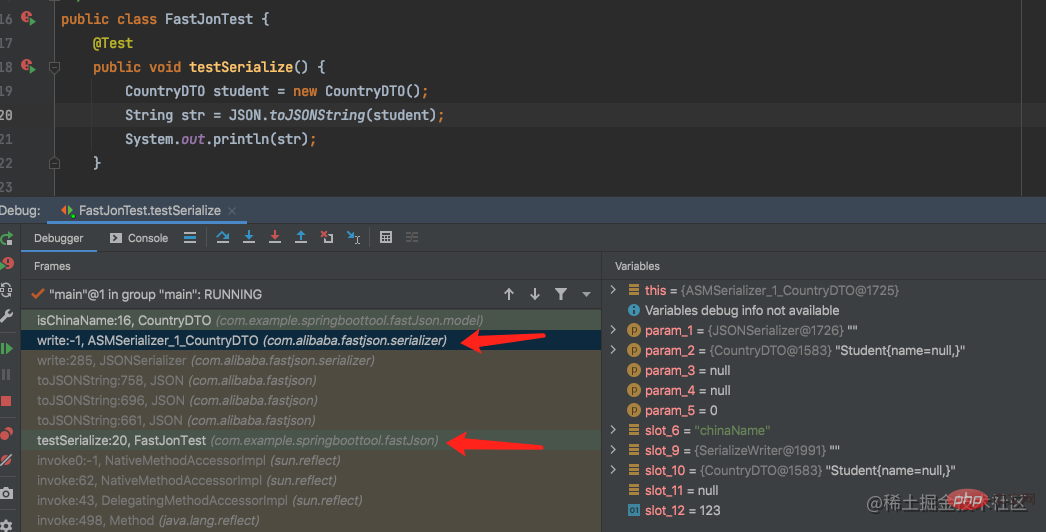
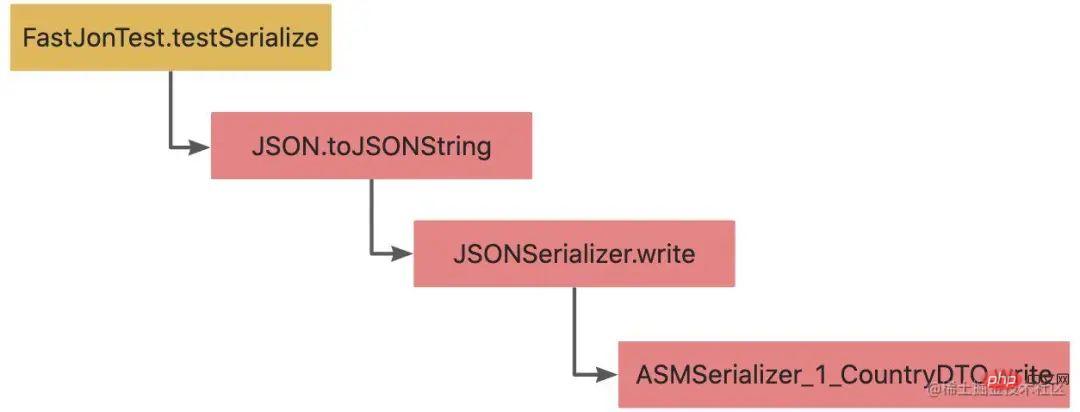
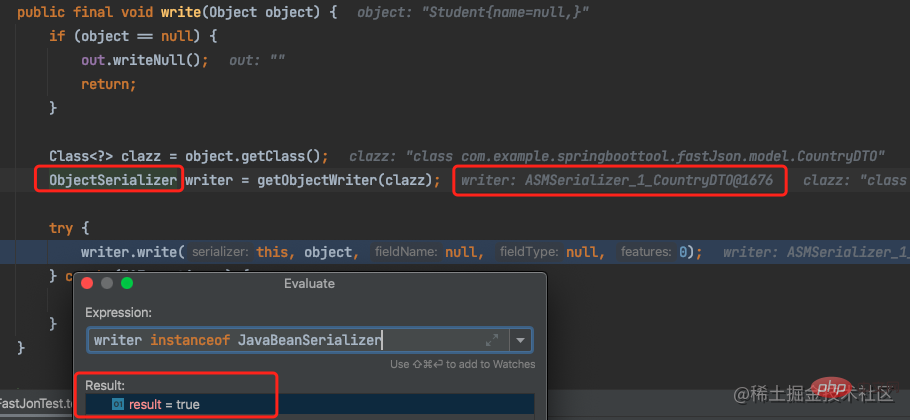 ObjectSerializer实现类JavaBeanSerializer
ObjectSerializer实现类JavaBeanSerializer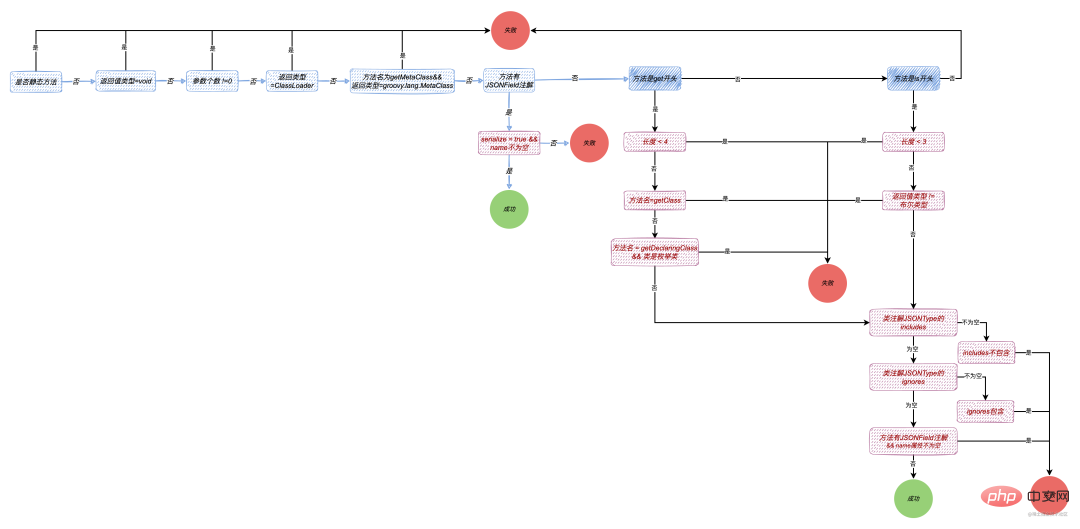 序列化流程图
序列化流程图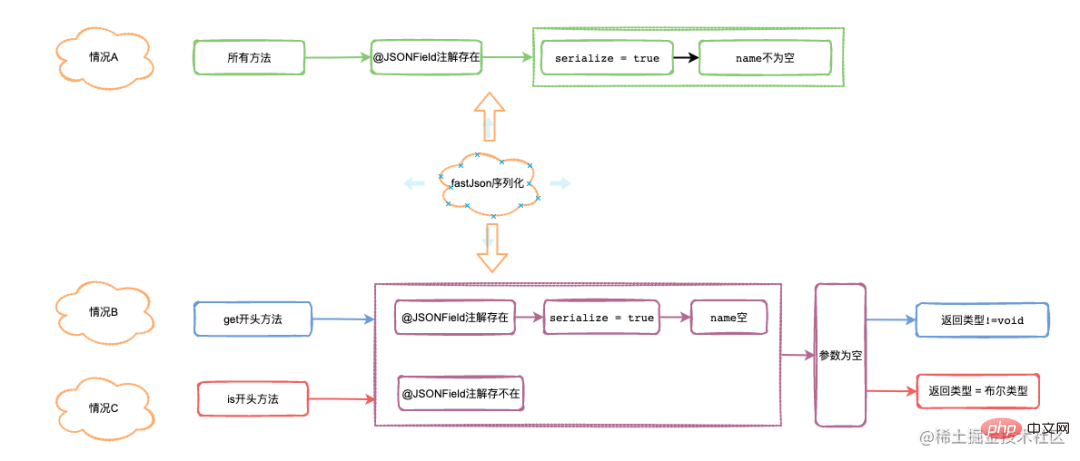 三个频率高的序列化的情况
三个频率高的序列化的情况